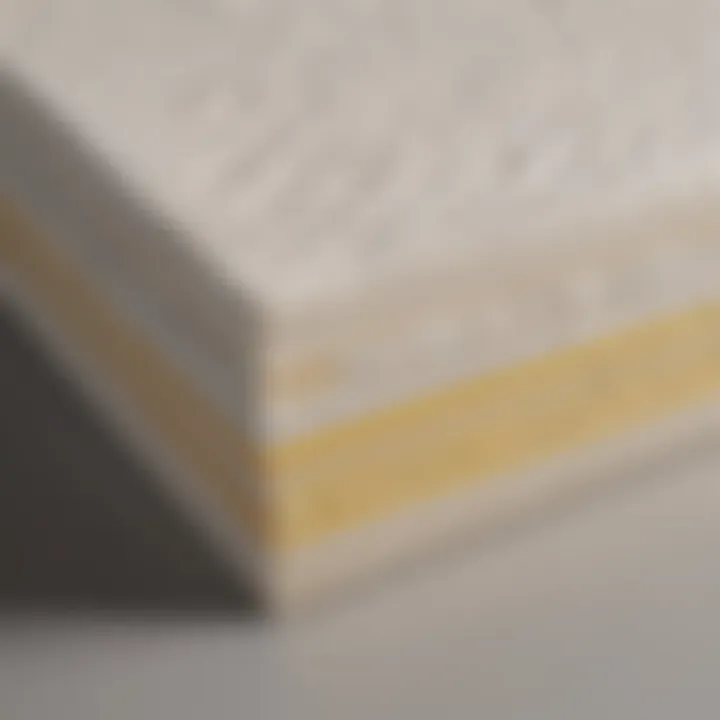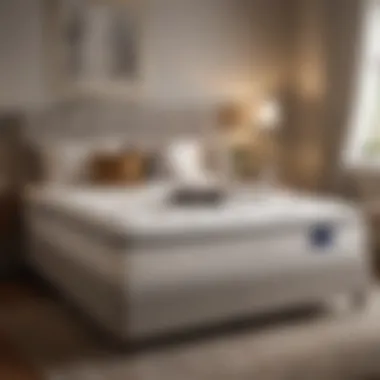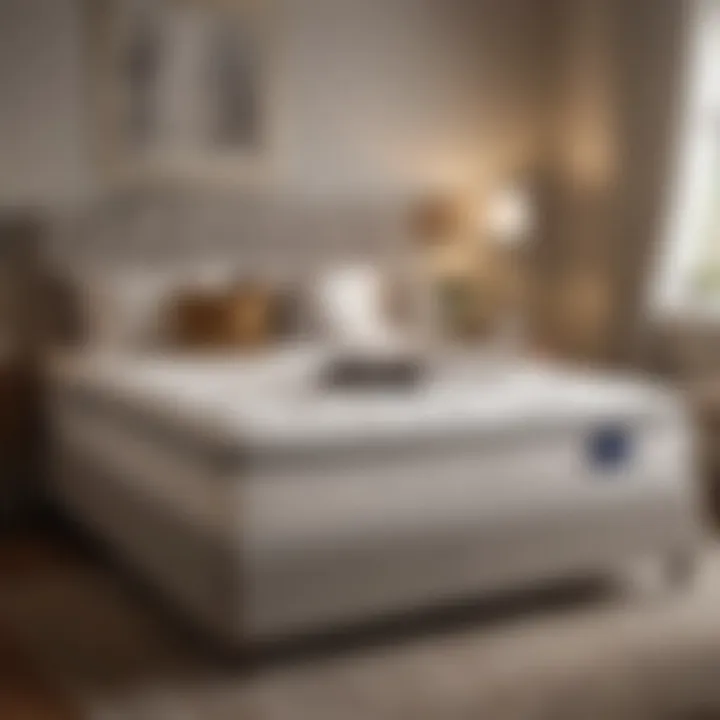Understanding the Initial Firmness of Memory Foam Mattresses


Intro
When stepping into the realm of sleep technology, memory foam mattresses often emerge as a buzzword that draws attention. With their ability to contour to body shapes, many folks are sold on the idea of supreme comfort. However, what many don’t realize is the initial stiffness that often greets them upon first contact. This article aims to tackle the often overlooked aspect of memory foam: its initial firmness. We’ll delve into the science and technology that underscore these mattresses, explore the factors that might affect how hard they feel initially, and provide valuable insights for making informed purchasing decisions.
Understanding initial firmness in memory foam is not just about comfort; it's also about expectations and reality. Many consumers often cringe at the term ‘firm’ when it comes to a mattress, associating it with discomfort. For the sake of clarity, it’s vital to untangle these perceptions and lay out a clear roadmap for potential buyers. This exploration will also touch on the adjustment period one might experience and how to maximize comfort when transitioning to a new mattress.
Overall, this guide serves as a no-nonsense resource aimed at demystifying what many might find puzzling. Our target audience, particularly housewives and homeowners, will benefit from this comprehensive overview, ensuring that everyone can make a more informed decision in the quest for a sound night's sleep.
Current Trends
In recent years, consumers have seen a surge in interest around memory foam mattresses. But what’s making these mattresses stand out amidst a crowded market?
Innovations in Technology
Newer models of memory foam mattresses are now being manufactured with cutting-edge technologies. The use of gel-infused memory foam, for instance, is gaining ground. This variation provides the benefits of traditional memory foam while introducing temperature regulation, creating a more inviting sleep experience right from a mattress's first use.
Color Palettes
When it comes to color, it’s not just about the aesthetics of the bedroom. Many brands are adopting calming color palettes to appeal to consumers looking for tranquility in their sleep environment. Soft blues, muted grays, and gentle earth tones help foster a serene atmosphere that can enhance sleep quality.
Popular Styles
Aside from color, the styles of memory foam mattresses are evolving. Now more than ever, hybrid options that combine memory foam with traditional spring support are trending. These hybrids often allow greater initial buoyancy while still providing that quintessential memory foam sink-in feeling over time. It’s a great mesh for those worried about diving into a sea of foam at the outset.
Visual Ideas
While some folks might be visual learners, seeing is believing when it comes to understanding how different mattress styles can fit into your living space. To give you a glimpse of what’s achievable:
- Gallery of Styled Bedrooms: Imagine a serene bedroom, anchored by a plush memory foam mattress that seems to melt into your decor. Soft linens and light accents complement the aesthetic, creating a perfect oasis.
- Before-and-After Transformations: For many homeowners, the journey to a comfortable sleep setup can feel daunting. Showcasing transformation examples—swapping out an old mattress for a new memory foam treasure—can illustrate just how impactful this investment can be.
To sum up, as we dive further into the nuances of memory foam mattresses, it’s essential to appreciate current trends, styles, and the decorative potential they bring to our personal havens. Understanding these elements can make all the difference when deciding on what may become the centerpiece of your nightly relaxation routine.
Foreword to Memory Foam Mattresses
In today's world, where sleep is often overshadowed by the hustle and bustle of daily life, the importance of a quality mattress can't be overstated. Memory foam mattresses have risen to prominence, capturing the interests of many housewives and homeowners alike. Understanding what makes these mattresses tick, especially their initial firmness, can significantly influence your sleep quality and wellness.
The initial firmness of memory foam mattresses is a hot topic for those looking to purchase a new bed. Many people find themselves bewildered by the sensation when they first lie down. It’s a bit like tasting a ripe avocado—you expect one thing, but the reality might surprise you. This article delves into the elements that create that firm feeling, the benefits of memory foam, and the considerations to keep in mind when shopping.
As we dissect memory foam, we'll uncover its composition and structure, how it interacts with heat and weight, and why it responds differently over time. Understanding these factors can empower you to make an informed choice that you’ll feel good about for years to come. It’s not just a mattress; it’s a long-term investment in your health and comfort.
Furthermore, we aim to address common misconceptions surrounding memory foam. Many think firmness ties directly to support, but that’s not the whole story. We’ll navigate through the nuances, helping you get a clearer picture of what to expect from a new mattress.
Ultimately, this exploration of memory foam mattress firmness serves as a stepping stone for those wanting a peaceful night’s sleep. By grasping the reality behind the initial firmness, buyers can sidestep disappointment and embrace the tranquil rest they deserve.
"A good mattress is an investment in your well-being. It’s the foundation of your sleep."
Let's dive deeper into what memory foam truly is and how it revolutionized the way we think about sleep surfaces.
What is Memory Foam?
Memory foam, originally developed by NASA, is a viscoelastic material designed to conform to the body. When you lie down, the foam reacts to your weight and temperature, softening and molding to your shape. This helps to alleviate pressure points, ensuring a more restful sleep. When you get up, the foam returns to its original form, ready for another night’s use.
The charm of memory foam lies in its ability to balance comfort and support. It cradles the body while offering a level of resilience that keeps the spine aligned. However, the initial feeling of firmness can be a stark contrast to these benefits, often leading buyers to question their investment.
History of Memory Foam Technology


Memory foam made its first appearance in the early 1960s, when NASA developed it to enhance the safety of aircraft seats. However, it wasn't until the late 1990s that it began to be marketed for consumer mattresses. At that time, the concept of mattress technology underwent a transformation.
From plain innerspring models to this innovative material, the market changed rapidly. As companies started to understand the benefits of memory foam, consumers were introduced to a new realm of sleep technology. Improvements have been made over the years—from better breathability to varied density levels—allowing homeowners to select a mattress that suits their individual needs and preferences.
In recent years, memory foam has become a household name, driven by online reviews and testimonials praising its comfort and support. Today, it remains a top contender in the mattress industry, continually evolving to accommodate the needs of modern sleepers.
The Sensation of Firmness in New Memory Foam Mattresses
Understanding the sensation of firmness in new memory foam mattresses is central to grasping the overall experience of sleep on such a surface. When you first lie down, the initial feel may create a stark contrast against the fluffy feel of traditional mattresses. This firmness can influence sleep quality, making it a key point of discussion. Not only does initial firmness affect comfort, but it can also shape perceptions about the mattress's supportiveness and longevity.
Many people often envision a mattress that welcomes them like a plush cloud. However, initial firmness can evoke surprises and sometimes disappointments for new users. If you overlook this sensation, you might misjudge the mattress's capability to cradle your body properly over time. Therefore, understanding this sensation is not just about comfort. It also highlights the importance of patience as you adjust to your mattress's unique properties.
In this context, let’s dive deeper into two vital aspects concerning initial firmness.
Initial Firmness Explained
When people hear the term "firmness" associated with mattresses, they often think of how hard or soft the sleeping surface feels upon entry. With memory foam mattresses, the initial firmness refers to the feel you experience immediately after laying down. This feeling can vary depending on several things, including the temperature of the room and the materials used in the mattress.
Here’s how it breaks down:
- Temperature Sensitivity: Memory foam is known for its temperature sensitivity. When it is colder, the foam tends to feel firmer. Conversely, when it's warm, the foam softens and contours to your body more.
- User Perception: Personal expectations can play a significant role. If someone is unused to the sensation, they may perceive it as excessively firm, especially after transitioning from a softer sleeping surface.
The adjustment period is crucial here. Understanding that this firmness can change with time and temperature helps ease concerns and expectations as people bed down on their new purchase.
Composition of Memory Foam
The make-up of a memory foam mattress directly influences its initial firmness. Memory foam is a special viscoelastic material, which responds uniquely to heat and pressure. The blend of materials can lead to variations in firmness levels, that’s essential for consumers to recognize.
- Polyurethane Foam: This is the main ingredient found in most memory foam mattresses. Its density determines the feel. Higher density foam typically results in a firmer surface.
- Gel-infused Foam: Many newer mattresses incorporate gel or other cooling agents, which make the memory foam feel cooler. While they help with temperature regulation, they can sometimes affect how firmly you feel the mattress on your first lie-down.
- Layering Techniques: Manufacturers use different layering strategies to offer varied firmness levels; some are constructed with softer top layers followed by firmer base supports. This layering impacts how you perceive firmness on first contact.
Ultimately, knowing the composition helps clarify why a memory foam mattress may feel firm at the start. Being aware of these factors enables potential buyers to make a more educated choice and prepare mentally for their new sleeping experience.
Factors Affecting Initial Firmness Perception
Understanding the factors that affect initial firmness perception in memory foam mattresses is crucial for potential buyers. When someone first sits or lies on a new mattress, their experience of firmness is influenced by several elements. These factors not only determine how comfortable a person feels but also shape their overall satisfaction with the mattress. By delving into these specifics, buyers can make informed decisions and better predict how the mattress will adapt to their body needs over time.
Environmental Temperature Influences
Many people may not realize how much room temperature can play a role in the firmness of their memory foam mattress. Memory foam is temperature-sensitive; its composition allows it to react to heat. When a person lays down, their body heat starts to soften the foam, causing it to cradle the body more comfortably.
- At cooler temperatures, the foam tends to be firmer, making it feel like a solid surface rather than the plush experience one may expect.
- Conversely, in a warm environment, the foam becomes softer and more accommodating.
This interaction means that if someone tries out a mattress in a colder showroom, they might think it’s too firm. But once it’s in their home, with body heat changing the temperature, they may discover a much softer feel.
"Adjusting the thermostat can be as significant as adjusting the mattress itself when it comes to comfort."
Body Weight and Distribution
Body weight and distribution can dramatically alter the perception of firmness in memory foam. A heavier individual exerts more pressure on the mattress, leading to a different level of firmness compared to a lighter person. The way someone distributes their weight on the mattress also matters. For instance:
- A heavier person lying flat may sink in more than a lighter person who might sit on the surface.
- Pressure points, like hips and shoulders, will create denser indentations, altering the feel dramatically.
This means that anyone considering a memory foam mattress should think about their body type and how they typically sleep. Those with larger frames may experience a softening effect sooner due to their weight, while lighter individuals may feel the mattress retains its firmness longer.
Mattress Top Layer Variations


The design of the mattress itself plays a pivotal role in the initial firmness experienced. Many memory foam mattresses have a top layer that differs in density from the underlying foam layers. Here’s how:
- Soft Top Layer: A mattress with a softer top layer will offer a plush feel right off the bat, often allowing for quicker conformity to the sleeper's body shape.
- Firm Top Layer: If the top layer is denser, it might feel considerably firmer initially, which can be a turn-off potentially.
It's important for buyers to consider the layers. A mattress with a balance of supportive yet cushioning layers can lead to a more favorable experience, where the initial firmness feels like a supportive hug, rather than a rigid board.
Adjustment Period: What to Expect
When you bring home a new memory foam mattress, the initial experience can sometimes feel like a mixed bag. Many users are caught off guard by the firmness they encounter right off the bat. Understanding the adjustment period is essential for making the most out of your investment. This phase isn’t just about breaking in the mattress; it’s about you, the user, adapting to a completely distinct sleeping environment. Recognizing this ensures a smoother transition and a more comfortable sleep experience.
Typical Adjustment Timescale
The timeline for adapting to a new memory foam mattress varies greatly from person to person. Typically, this period spans anywhere from a few days to a couple of weeks. While some may find that their bodies acclimate within a matter of days, others might take up to 30 days to fully adjust. Factors affecting this period include:
- Body weight: Heavier individuals might sink deeper into the mattress, altering their experience significantly.
- Sleep position: Side sleepers might notice a difference in how the mattress responds compared to back or stomach sleepers.
- Environment: Ambient temperature can influence how the foam reacts. Colder conditions might make the foam feel firmer.
It's important to keep in mind that initial firmness doesn’t reflect the long-term performance of the mattress. During the adjustment phase, your body gradually begins to adapt to the memory foam’s contours, enhancing support in areas that require it.
Signs of Improving Comfort
As your body becomes accustomed to the new mattress, various signs indicate that comfort levels are improving. Observing these changes can help assure you that the investment was the right choice. Common signs to look for include:
- Decreased Pressure Points: If you wake up feeling less stiff than you did during the initial nights, that’s a positive sign. A good memory foam mattress spreads your weight evenly, reducing discomfort.
- Improved Sleep Quality: Are you getting more restful sleep? If you find that you’re falling asleep faster and waking up less during the night, that’s a shining indicator of adaptation.
- Less Soreness: If you notice a reduction in aches and pains after sleeping, that suggests your body is adjusting well to the mattress's contouring ability.
"Patience is a virtue." This old saying holds true when dealing with the adjustment period of a memory foam mattress. Take your time and give your body the chance to adapt.
Some may even go through a phase of wavering comfort. At times, it might feel too soft or too firm. This ebb and flow is perfectly normal. Understanding that both firmness and supportive qualities are dynamic will allow you to navigate through this transitional period with greater ease. Remember, the ultimate goal is finding a mattress that you can comfortably rely on night after night.
By embracing the adjustment phase, you not only enhance your overall sleep experience but also gain a better understanding of what works best for your body. This knowledge empowers you as a consumer, allowing you to make informed choices about sleep products in the future.
Common Misconceptions About Firmness
When diving into the realm of memory foam mattresses, several misconceptions about firmness often arise. Understanding these notions is crucial, particularly for those seeking a sleep solution that not only caters to comfort but also supports sound sleep. Misunderstandings can lead to poor purchasing decisions or dissatisfaction with a mattress that could otherwise have provided significant benefits. Let's clear the air on two common myths surrounding firmness that can guide your future choices.
Firmness Equals Support
One of the prevalent misconceptions is the notion that a firmer mattress automatically means better support. While it's true that support is critical for spinal alignment and overall comfort, firmness is just one piece of the puzzle. In reality, a memory foam mattress can feel soft to the touch, yet provide exceptional support by conforming to the body's contours.
- Support refers to how well a mattress keeps the spine aligned. A mattress that supports your body well redistributes weight evenly to relieve pressure points.
- Firmness, on the other hand, is about the feel of the mattress. This can greatly vary based on the materials used and individual body weight.
It's essential for potential buyers to look for a balance between support and firmness, rather than equating the two. Just because a mattress is hard as a rock doesn’t mean it’ll keep the spine aligned. Instead, a softer mattress that conforms and redistributes weight can often provide better support, especially for those with specific sleeping positions.
Memory Foam Softens Over Time
Another widespread belief is that memory foam mattresses will inevitably soften over time. While it is true that they can adjust to body temperature and weight, leading to a softer feel as users break them in, this does not mean they lose support.
- Natural softening: New memory foam mattresses may feel extremely firm initially. Over a few weeks of regular use, users often find the materials soften slightly, which can enhance comfort. It’s the memory foam’s ability to conform, not weaken, that’s key.
- Quality matters: The rate and volume of softening largely depend on the quality of the materials used. Lower quality foams may degrade faster, creating issues in support over time.
Remember, after the initial firmness feels off-putting, there’s an adjustment period when memory foam tends to reshape itself according to the sleeper’s body contour. Therefore, it is critical to wait it out and assess long-term comfort before casting judgement on the firmness.
"A mattress is not just a surface to sleep on but a critical support system that contributes to restful nights and active days."
Recommendations for Buyers Considering Memory Foam
When it comes to selecting a memory foam mattress, an informed choice can make all the difference. With the growing variety of options available, understanding what to look for in terms of specifications, comfort, and durability is crucial for ensuring a satisfying sleep experience.


The initial firmness of a memory foam mattress can be deceiving. Many buyers may find that their first encounter with the mattress feels firmer than they anticipated. However, this is not indicative of the overall comfort and support the mattress will provide over time. Recognizing how different elements can affect comfort is vital, and knowledge about these specifics can guide you toward a mattress that best caters to your needs.
Reviewing Mattress Specifications
Delving into mattress specifications can feel like deciphering a secret code, but it’s simpler than it appears. Here’s what to keep in mind:
- Density and ILD Rating: The density of the foam impacts how well it contours to your body. A higher density foam offers better durability and support, while the Indentation Load Deflection (ILD) rating tells you how soft or firm the mattress feels. For those seeking a balance between comfort and support, aim for a medium-density foam with an ILD of 10-12.
- Layer Composition: Not all memory foam is created equal. Check if the mattress includes a top layer of cooling gel or traditional foam. Cooling features can be essential for those who tend to sleep hot.
- Certifications: Certifications like CertiPUR-US® ensure that the foam is free from harmful chemicals and meets rigorous standards for safety and performance. This can provide peace of mind as you invest in a new mattress.
"A mattress is a long-term investment; knowing what’s inside can safeguard your comfort for years to come."
Testing Before Purchase
Before diving into a purchase, it’s wise to test the mattress in person if possible. Here’s how you can effectively evaluate your options:
- Lie Down: Spend a good five to ten minutes lying on the mattress. Position yourself in your typical sleeping posture — whether it's on your back, side, or stomach. Pay attention to how the mattress feels under your body.
- Check the Edges: Don’t forget to sit on the edge of the mattress. It provides useful insight into the stability and support you can expect when getting in and out of bed or sitting to read.
- Take Advantage of Trials: Many companies offer in-home sleep trials. If this is an option, take it! It allows you the flexibility to see how the mattress performs over a span of several nights.
Caring for Your Memory Foam Mattress
Caring for a memory foam mattress is essential not just for its longevity, but also for maintaining the comfort level you want. If you're investing in a quality sleep surface, it pays to know how to keep it in tiptop shape. Proper care ensures that you reap all the benefits of this advanced material while avoiding common pitfalls that can lead to premature wear and diminished support.
Proper Cleaning Techniques
When it comes to cleaning a memory foam mattress, gentleness is the name of the game. Unlike traditional mattresses, which can tolerate a good scrubbing, memory foam requires a more subtle approach. Here are some essential tips:
- Spot Clean Only: Avoid soaking the mattress with water. For stains, use a mild detergent mixed with water on a clean cloth and dab at the stain gently.
- Baking Soda Magic: If there are odors, sprinkle baking soda evenly across the surface, let it sit for a few hours, then vacuum it up. It’s a great way to refresh the mattress without chemicals.
- Avoid Harsh Chemicals: Strong cleansers can break down the foam and worsen the firmness over time. Stick to mild soap and water.
Using a protector can save you loads of hassle. Invest in a good quality mattress protector to guard against dust mites, spills, and wear. It’s a small price to pay for peace of mind.
Maintaining Optimal Condition
Maintaining a memory foam mattress isn’t just about cleaning; it involves some regular habits to keep its form and function intact. Here are a few key practices:
- Rotate Regularly: Give the mattress a spin every few months. This will prevent any uneven wear and keep things balanced. You wouldn’t want a lopsided bed, now would ya?
- Keep Away from Heat: Memory foam reacts to temperature, so keep it away from heat sources. Direct sun or heat can affect its properties and lead it to lose that comfy feel it had when new.
- Check for Sagging: Every now and then, have a look for any signs of sagging or indentations. If you notice any, moving the mattress or adding a supportive board underneath can help.
"Proper care not only enhances comfort but can also extend the life of your mattress, allowing you to enjoy it for years to come."
By adhering to these cleaning and maintenance techniques, you'll keep your memory foam mattress in prime condition. Whether it's ensuring that spot stains don’t linger or practicing a regular rotation schedule, these steps can contribute significantly to prolonging the lifespan of your mattress, thus keeping your sleep sanctuary intact.
The End: Making an Informed Decision
In today's market, where nearly every product touts a breakthrough, understanding what you're buying becomes essential—especially when it comes to something as personal as a mattress. This article emphasizes the striking initial firmness of memory foam and how it relates to real-world comfort needs.
When making a decision about a memory foam mattress, it's crucial to remember that firmness isn't the sole factor determining comfort. Many folks mistakenly equate firmness with support, leading to some poor choices. Take a step back and consider the long-term. Think of those cold winter nights, where your mattress responds to your shape and warmth, cradling your body in a way that makes you feel like you’re floating.
Let's break this down into two primary considerations that can influence your final decision:
Weighing Long-Term Benefits
When it comes to memory foam mattresses, weighing the long-term benefits is not just a practical approach, but a necessary one. These mattresses are known for their durability. If you invest in a quality memory foam mattress, users often report it maintaining its integrity for a decade or even longer—certainly much longer than traditional mattresses. This makes it a wise investment in both health and finances.
Additionally, many buyers don't consider how their posture will benefit from a proper mattress alignment over time. A good memory foam mattress can cradle your body, reducing pressure points. This can lead to better sleep quality and, in turn, improved daily performance.
- Positional flexibility: They adapt to various sleeping positions, allowing for seamless transition from back to side and everything in between.
- Reduced bed partner disturbances: You less likely to feel your partner's movements thanks to the motion isolation properties of foam.
Evaluating Personal Comfort Needs
Not every mattress is suitable for everybody. This simple truth often escapes potential buyers. As discussed earlier, a mattress that feels too firm initially can lead some to overlook its merits over time. Evaluating personal comfort needs should be a high priority.
- Sleeping habits: Do you curl up in a ball or sprawl? Assess how you sleep before making that purchase.
- Body weight and distribution: Heavier individuals might find that a firmer feel offers necessary support, while lighter folks could benefit from the plush embrace of a softer mattress.
Getting to know your comfort needs is like digging through a pile of clothes to find that perfect fit. It may take some time, but the right mattress will not only match your sleep style but also become a cornerstone of your wellbeing.
In synopsis, this article has put a spotlight on how to make an informed decision when considering a memory foam mattress. Equipped with knowledge about the initial firmness and its implications, buyers can now navigate their choices more wisely.



